Uncategorised
Japanese Honeysuckle (Lonicera japonica)
- Details
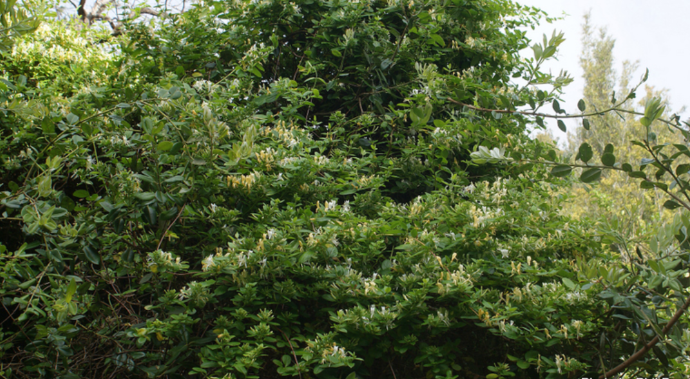 A native of China and Japan. Japanese Honeysuckle is a vigorous climber with soft green leaves and pale yellow, sweetly scented flowers which self layers and quickly grows up and over shrubs and small trees, smothering them. The black berries are carried by the birds.
A native of China and Japan. Japanese Honeysuckle is a vigorous climber with soft green leaves and pale yellow, sweetly scented flowers which self layers and quickly grows up and over shrubs and small trees, smothering them. The black berries are carried by the birds.
Japanese Honeysuckle is a vigorous, fast growing scrambling and climbing shrub with distinctive pinkish new stems. Old stems can become thick and gnarly.
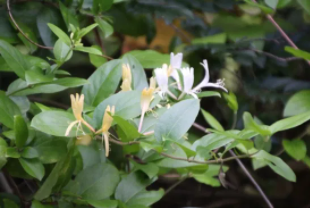
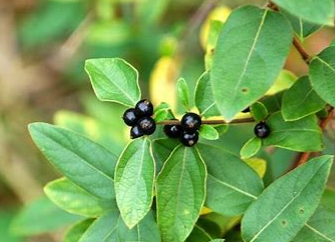 Spring is a good time to identify Japanese Honeysuckle, a creeper with its distinctive small yellow cream to white flowers with a pink tube. Flowers occur in pairs and mostly in spring to autumn. Flowers are fragrant and nectar-filled.
Spring is a good time to identify Japanese Honeysuckle, a creeper with its distinctive small yellow cream to white flowers with a pink tube. Flowers occur in pairs and mostly in spring to autumn. Flowers are fragrant and nectar-filled.
Small shiny black berries 6–10 mm long occur in autumn.
Impact on bushland
Japanese Honeysuckle grows rapidly and forms a dense shade over shrubs and low canopy trees, blocking the light, breaking branches and causing loss of biodiversity.
Control
Japanese Honeysuckle twines in and around other plants, making it difficult to control.
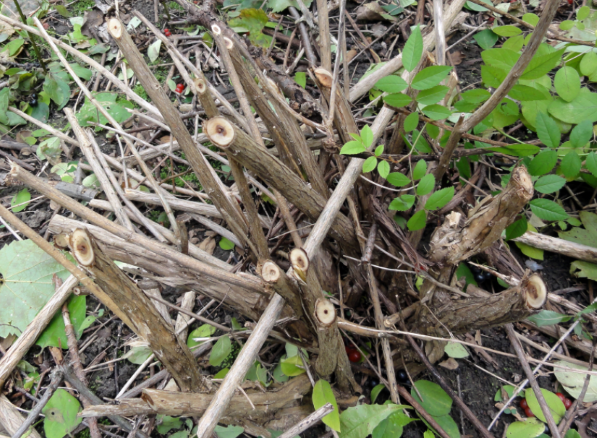
Vines climbing up shrubs or trees:
- Scrape each stem as far as possible and paint; suspended vines can then be cut and left in place.
- Suspended vines are easily identified as they look like gnarly paperbark vines.
- Cut and paint large crowns and scrape and paint as many roots as possible.
Vines growing on the ground:
- Pull out by hand, making sure all root and stem parts are removed. Cut material can be spread out off the ground. Once dead, it will decompose in place.
- Where the foliage is dense, treat with herbicide if there are no native plants or water nearby.
Berries are spread by birds, so treat plants before they fruit.
Do not pull dead or alive vines out of trees as this may damage the tree and it may be habitat for microbats and other small animals.
Common Holly (Ilex Aquifolium)
- Details
After English Ivy, Common Holly is the most ubiquitous weed in Mt Wilson.
There are many old established Holly Trees and hedges in Mt Wilson. Whilst owners may be reluctant to remove these, care should be taken to stop the spread of Holly trees. Holly gets established very quickly and it is easiest to remove when the plants are still small. When they are seedlings they can sometimes be dug up as long as all roots are removed. Holly cuttings should all be placed in the green bin, mulched or burnt as they reshoot very easily.
The extract below is from Libby Raines weed booklet.
A native of Europe to China and North Africa. Holly is a large fast growing evergreen shrub (a small tree on Mount Wilson). It has very prickly shining green leaves and many red berries in the Autumn, which are carried by the birds. Each berry contains up to four seeds, which germinate readily in our ideal conditions, especially in the shade, and they quickly make a large self-layering shrub which usually shades out everything else around it.
Holly can be seen almost everywhere you walk on good soil. Holly and Ivy are the two most serious weeds on Mount Wilson. It is heartening to see many land owners removing holly trees from their properties.
The variegated forms of Holly are suitable to grow.
Control
- Pull or dig out small plants or spray December to March.
- Large plants cut off and poison.
Resources
White Jasmine (Jasminum polyanthum)
- Details
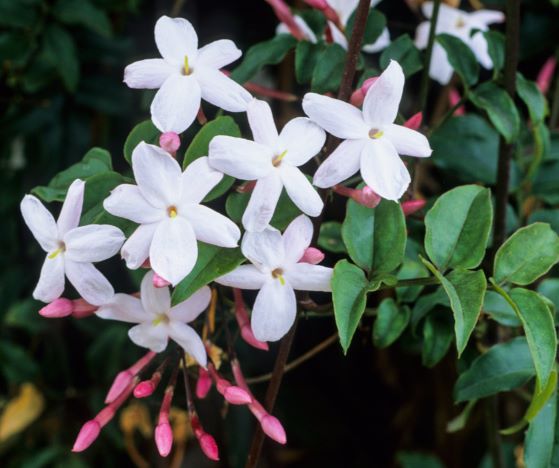 Jasmine provides a very scented and pretty creeper but this needs to be controlled as Jasmine is a serious weed in the Rainforest.
Jasmine provides a very scented and pretty creeper but this needs to be controlled as Jasmine is a serious weed in the Rainforest.
Type of weed: Climber, scrambler or groundcover
Flowering Months: September, October, November
Native of China. A fast growing evergreen climber with small shiny green leaves and white flowers which are pink in bud and sweetly scented. Jasmine spreads by self-layering and occasional setting of seed. It can seriously threaten the rainforest edges of Mt Wilson. This plant has become a big problem in some gardens.
Alert: The flowers can cause allergies in some people.
Don’t confuse with… Jasmine can be confused with native Wonga Wonga Vine (Pandorea pandorana) before the plant develops the distinctive lobed leaves and before it flowers.
Impact on bushland
Jasmine climbs rapidly into the tree canopy and covers vegetation at all levels, blocking light and restricting the growth and regeneration of native species. Its weight may bring down branches. It is a serious weed of rainforests.
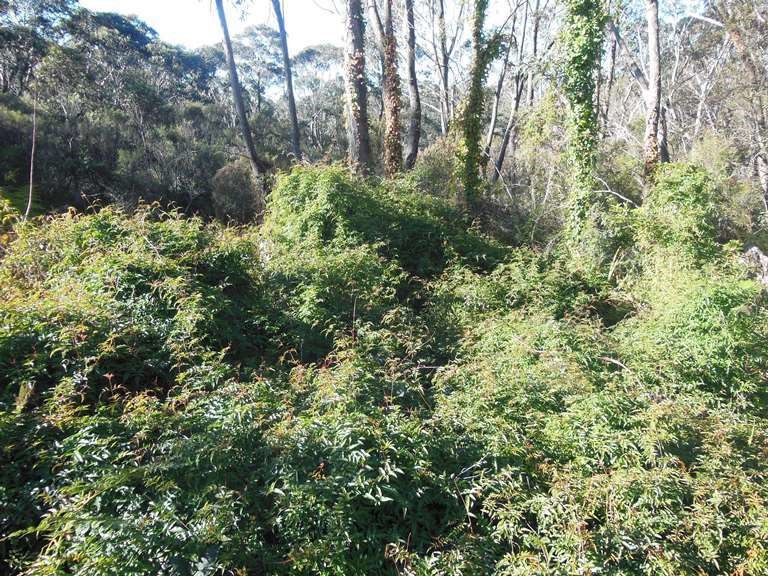
Prevention
- Keep well pruned
Control
Because of the fine twining stems and vigorous nature of this plant it is hard to eradicate.
- Dig out or spray December to March.
- Scrape and paint stems.
- If the vine has grown up into the canopy of a tree or shrub, cut each of the vine stems about 500 mm above the ground, after scraping and painting above and below the planned cut, to allow the parts in the tree canopy to die. It is important to keep the cut low to allow adequate length of the stems to be reached for re-treatment.
Alternative native plantings
- Twining Purple Pea (Hardenbergia violacea)
- Wonga Wonga Vine (Pandorea pandorana)
- Water Vine (Cissus antarctica)
- Old Man’s Beard (Clematis aristata) - note: not Clematis cultivars as these can also be environmental weeds.
Current Bushfire Status
- Details
Update about the Gospers Mountain Fire to the north of us, posted Wednesday, 11 December.
Gospers Mountain Bushfire Update - Plan to begin backburning today.
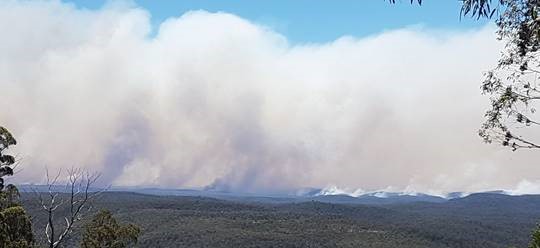
The Gospers Mountain bushfire seen yesterday from Smiths Hill was about 6 kms from Mount Irvine
The Fire
While we have a good weather window MWMIRFS Brigade will commence back burning into the area below Mount Irvine today to take advantage of the better conditions for creating a safety burnt area around Mt Irvine. This will involve lighting the bush from the fire trails around Mount Irvine then Mount Wilson to remove the fuel between the villages and the Gospers Mountain fire thereby protecting property in the villages. The back burn is a lower intensity burn usually lit at night and going downhill so as to reduce the impact on the surrounding bush while removing the fuel and protecting the area from the bushfire coming into the villages on a bad day.
On Tuesday the fire was holding on Bungleboori Creek (see yesterday’s Update map), north of Mt Wilson / Mt Irvine, but quite active on the Newnes Plateau. The back burn started at Mountain Lagoon has progressed as far as Bilpin. After a very hot day yesterday we are entering a good weather window until about Friday.
Access to the Mounts
A road block at Mt Wilson Road and the Bells Line of Road will restrict access to all vehicles other than residents and emergency services. Expect this to be in place for a couple of weeks.
Letters of authority were distributed last night to all residents providing access to named people on the presentation of the letter and ID like a local rates’ notice or a driver’s licence. If you need an authority for anyone else (other than Mount Wilson or Mount Irvine residents) please email to This email address is being protected from spambots. You need JavaScript enabled to view it. stating: first name, family name and email address. A personalised authority letter will be sent to the nominated person.
The trigger point for fire plans
The start of backburning is the trigger point for people to carry out their fire plans. If you plan to leave, today is the time to relocate. Leave, stay or come to the Mounts this is also the time to contact your Street Coordinator and tell them what you will be doing. A fire warning message may be sent to all mobile phones in the area when fire reaches a preset zone around both villages . Do not be alarmed by this, just follow the prompts and check with your street coordinator if the situation or conditions may have changed.
Once backburning starts we will see an increase of smoke in the area. From today expect increased movement of trucks, activity around both community halls and fire stations and road closures in areas as the backburn progress from Mount Irvine to Mount Wilson and on along Mt Wilson Road to Bells Line of Road.
Please slow down on the local roads, if possible pull over and let tucks pass. Do not enter the fire trails or the burn area as there will be many hazards, machinery operating, steep trails, falling trees and hot ash beds.
Anyone who would like to assist with Catering or Station work please contact the Brigade Station Officer on 4756 2168.
Peter Raines
Senior Deputy Captain
Mt Wilson-Mt Irvine RF Brigade
Map of Fires in NSW with the current status of each fire, Fires Near Me.
The map can be zoomed to show fires in our area.
Himalayan Honeysuckle (Leycesteria formosa)
- Details
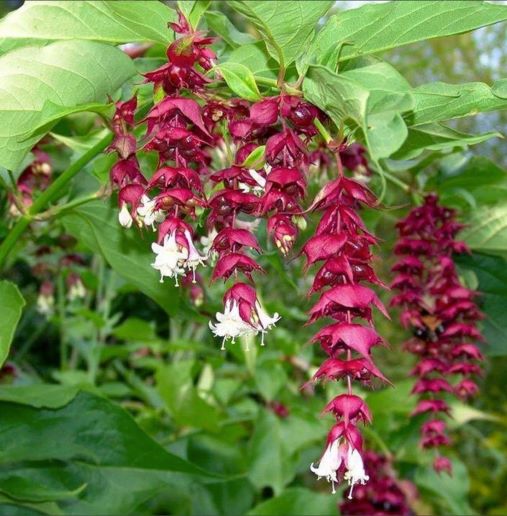 Himalayan Honeysuckle invades sensitive moist bushland such as Blue Mountains swamps where it forms thickets and dense shade, displacing native vegetation.
Himalayan Honeysuckle invades sensitive moist bushland such as Blue Mountains swamps where it forms thickets and dense shade, displacing native vegetation.
A deciduous multi-stemmed shrub to 3 m high. Stems are erect, hollow and bamboo-like. A native of the Himalayas. Leycesteria is a vigorous arching shrub with large, soft green leaves and drooping panicles of white flowers which are followed by clusters of shining dark purple berries spread in December and January by the birds. These plants grow well in the semi-shade of the rainforest.
Fruits are ovoid fleshy berries, dark crimson when ripe. Each fruit contains more than 100 small seeds.
Control
- The plant should be fully and continuously suppressed and destroyed
- Dig out, or cut off and poison every stem.
- Spray large areas November to March.
